|
|
|
| My Favourite Planet > English > Middle East > Turkey > Selçuk > photo gallery 2 |
| Selçuk gallery 2 |
Ephesus Museum, Selçuk |
 |
 |
2 of 10 |
 |
 |
|
| |

Dionysus, Ariadne and Pan in a floor mosaic, in Ephesus Archaeological Museum (2004). |
| |
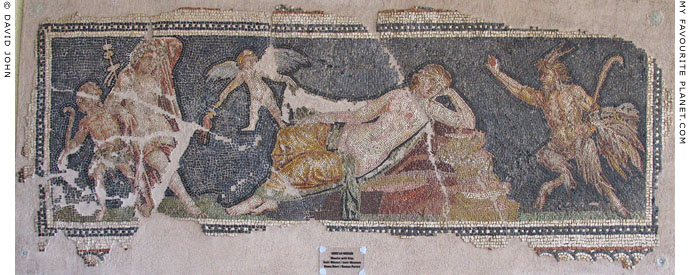
The same mosaic in Izmir Archaeological Museum (2012). |
| |
For further details about the Ephesus Archaeological Museum,
including opening times, see page 4: sightseeing in Selçuk. |
| |
I took the top photo of the mosaic in Ephesus Museum in April 2004 and first published it online shortly after. However, I could find no reference to it in literature about Ephesus or the museum. Then, while visiting Izmir Archaeological Museum (İzmir Arkeoloji Müzesi) in 2012, I photographed what I thought was a remarkably similar mosaic. When I compared the photos, I realized that it was the same. It appears that it was on loan to the Ephesus Museum at the time, and has since been returned to Izmir.
I suppose this means I should really remove this photo from this gallery, which I probably will when I get around to updating it, sometime...
On the other hand, this work may well have come from Ephesus, since it is now exhibited in Izmir Museum near to other objects from the ancient city. If anybody out there knows about the provenance of this mosaic, please get in contact.
Typical of the Izmir Museum, the labelling is not only unhelpful, but quite misleading. It merely states: "Mosaic with Eros (in Turkish, Eros'lu Mozaik), Izmir Museum, Roman Period". There is no mention of the find spot (the location where it was found) or even its invoice number. I have seen photos of the mosaic titled as "Sleeping Aphrodite", which is incorrect.
The image of the Sleeping Ariadne was very popular in ancient art, appearing on pottery and in painting, sculpture and mosaic all around the Graeco-Roman world, from Britain to North Africa (e.g. Morocco, Tunisia and Lybia) and Asia. A particularly fine, more painterly mosaic featuring this scene, from 200-250 AD, can be seen in Thessaloniki Archaeological Museum, Greece (see photo below).
There are many versions of the Greek myths concerning Ariadne (Ἀριάδνη), "the darling of the gods", the daughter of Pasiphae and King Minos of Crete. As Plutarch wrote, probably in exasperation: "There are many other stories about ... Ariadne, but they do not agree at all." (Life of Theseus, 20.1)
But the jist of the best known story is that she helped the Athenian hero Theseus kill the Minotaur and escape from Minos' labyrinth by giving him a length of thread she had been given by Hephaistos. Theseus promised to marry her, and she sailed from Crete with him. However, he abandoned her on the island of Naxos (Dea).
While asleep there she was discovered by Dionysus, the god of wine, revelry and rebirth, and his thiasos (retinue). "Amazed by her beauty", he fell in love with her and she became his wife.
In other versions Dionysus forced Theseus to leave her or warned him to do so in a dream. In yet another version, she was killed on Naxos by Artemis, and Dionysus brought her back to life.
When she died, Dionysus transformed her into the ring of stars known as Ariadne's Crown (the Corona constellation). |
|
| |
| |
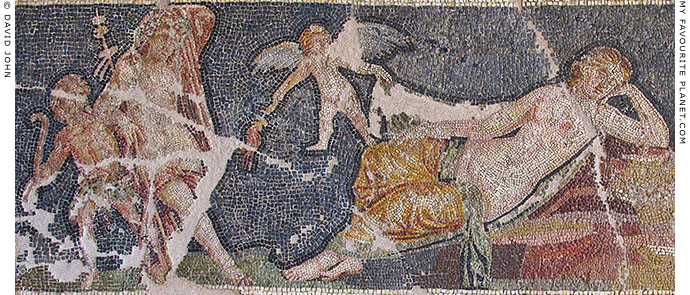
Detail of the Sleeping Ariadne mosaic. |
| |

Detail of a Sleeping Ariadne mosaic, 200-250 AD, in Thessaloniki Archaeological Museum, Greece.
|
In this oft-repeated image, Ariadne lies asleep on a rock (representing the island of Naxos, or a particular mountain?) in the centre of the picture. The drunken Dionysus (photo, right), entering from the left, supported by a satyr (one of his companions) and carrying his symbolic thyrsos wand, discovers the slumbering beauty. A flying Eros lifts the top of her garment to reveal her half naked.
To the right Pan dances with his right arm raised. Some have interpreted this figure as a satyr. Commenting on an ancient painting of this scene, the Greek rhetorician Philostratus the Elder (3rd century AD) wrote, "... nay, even Pan checks his wild dance that he may not disturb the maiden's sleep." (Imagines, 1.15)
The 2nd century AD Greek travel writer Pausanias, describing "pictures" (presumed by modern scholars to mean paintings) in the Temple of Dionysos in Athens, mentions another representation of this story:
"Beside this picture, there are also represented ... Ariadne asleep, Theseus putting out to sea, and Dionysus on his arrival to carry off Ariadne."
(Description of Greece, Book 1, chapter 20, section 3.
Ancient paintings, from which many mosaic images are thought to have been copied, could include more details than was practicable for most mosaic makers'
budgets. Mosaic-making is very labour intensive, and the materials expensive, so only the richest customers could afford highly detailed images. The size of the tesserae and of the room for which such mosaic floors were made were also limitations to the compositional possibilities.
Although the mosaic in Thessaloniki is a very fine, detailed work, its counterpart in Izmir is neither well-detailed nor of the highest quality workmanship, and it probably owes its compositional dynamics to another work or works from which it may have been copied. The individual figures are certainly not original compositions, and the sleeping Ariadne and the drunken Dionysus supported by a satyr are known from extant ancient sculptures.
But this is an attractive work, with plenty of raw energy, and would no doubt have looked splendid on the dining room floor of a villa, particularly after the symposium wine had been passed around a few times. |
| |
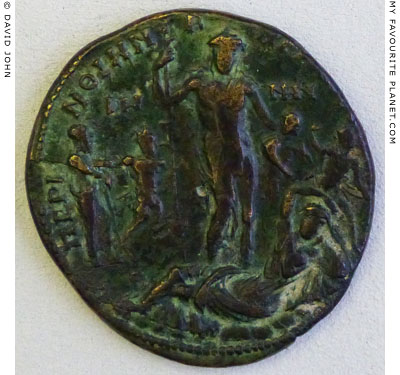
Coin from Perinthos, Thrace, showing Dionysus
discovering Ariadne on Naxos. 222-235 AD.
Bode Museum, Berlin.
| |
More photos and information
about mosaics
on My Favourite Planet:
Hellenistic mosaics in Pella, Greece.
The "Alexander Mosaic" from Pompeii, depicting
Alexander the Great in battle with King Darius III:
Alexander the Great
in the MFP People People section
A Hellenistic mosaic, signed by Hephaistion,
from Pergamon, in the Pergamon Museum, Berlin:
Pergamon photo gallery 2
Ancient mosaics depicting the Gorgon Medusa
Mosaics from Pompeii
signed by Dioskourides of Samos
Mosaics at Dion Archaeological Site, Macedonia, Greece:
Dion: garden of the Gods
at the Cheshire Cat Blog
"Choklakia" mosaics in Kastellorizo, Greece:
Kastellorizo photo gallery
Mosaics of Saint John the Theologian, on Patmos, Greece:
Patmos photo gallery
Modern mosaic commemorating Saint Paul
the Apostle's visit to Veria, Macedonia, Greece:
Veria photo gallery
See also a mosaic mural made
by the author of this guide:
davidjohnberlin.de |
|
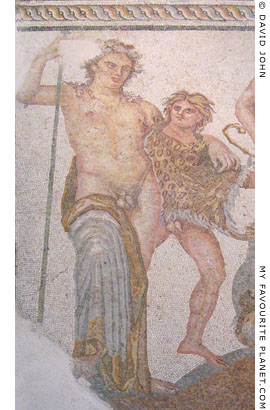
Dionysus, supported by a satyr in a
leopard skin, discovers the sleeping
Ariadne, in the Thessaloniki mosaic
(see photo above).
Thessaloniki Archaeological Museum. |
| |
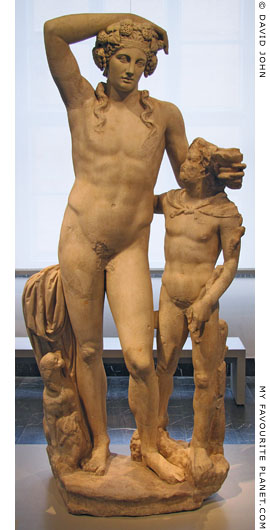
Marble statue group of Dionysos and
a young satyr. 160-170 AD. From the
Faustina Baths, Miletus, Turkey.
Altes Museum, Berlin. Inv. No. Sk 1797. |
| |
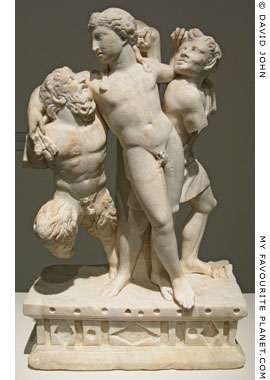
A marble table support depicting
a drunken Dionysus supported
by Pan (left) and a young satyr.
Roman period, mid 2nd century AD.
Pergamon Museum, Berlin. |
| |
| |

Dionysus and a satyr discover the sleeping Ariadne. Two erotes (cupids) fly above the satyr.
A 1st century AD glass cameo panel found, with the similar panel below, in the House of
Marcus Fabius Rufus, Pompeii. It is thought that the panels were made in imitation of ivory
panels, and used as wall decorations or furniture inlays.
Height 25.2 cm, length 40 cm, thickness 0.9 cm.
National Archaeological Museum Naples, Italy. Inv. No. 153652. |
| |
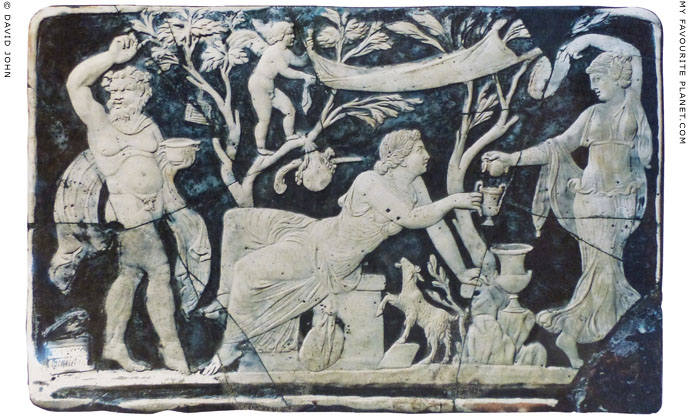
Ariadne is served wine by a dancing female figure (probably a Maenad), while an elderly
satyr (or Silenos) dances. Eros, standing in a tree, wafts a cloth over her to provide her
with shade. The goat and other objects on the panel are symbols of the cult of Dionysus,
and of Pan as a member of Dionysus' retinue (thiasos).
Height 25.2 cm, length 39.4 cm, thickness 0.7 cm.
National Archaeological Museum Naples, Italy. Inv. No. 153651.
|
According to the museum labelling, the museum's website and associated literature, the theme of these glass panels, which are are exhibited next to each other, is variously described as "the epiphany of Dionysus and Ariadne", "the initiation of Ariadne to the Dionysian mysteries" and "the apotheosis of Ariadne".
These descriptions have less to do with the subjects of the individual images and more to do with the practices of the Dionysian mystery cult, the exact nature of which modern scholars have limited knowledge. The rites of the cult are thought to have included enactment by the initiates of scenes from the myths about Dionysus, including his holy marriage (ἱερὸς γάμος, hieros gamos) with Ariadne, and her elevation to a divine being (ἀποθέωσις, apotheosis).
It may be interesting, and perhaps not too far-fetched, to speculate over whether these two surviving panels were part of a larger series of images depicting key phases (as in stations) of such a sacramental narrative. |
|
|
| |
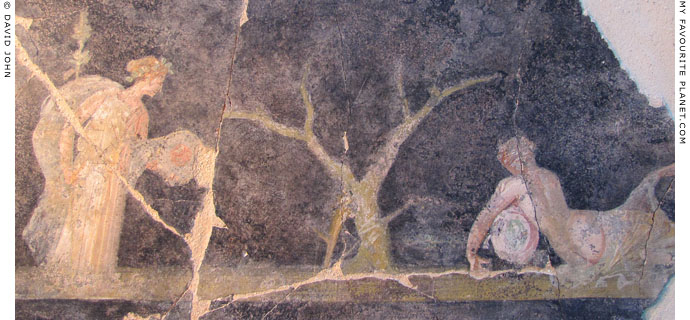
Detail of a fresco, in the 3rd Pompeian style, of Dionysus discovering the sleeping Ariadne on Naxos.
From Venafro (Greek, Οὐέναφρον; Latin, Venafrum), central Italy, 1st century AD.
Photo taken at an exhibition dedicated to Dionysus in Thessaloniki Archaeological Museum, 2012. |
| |
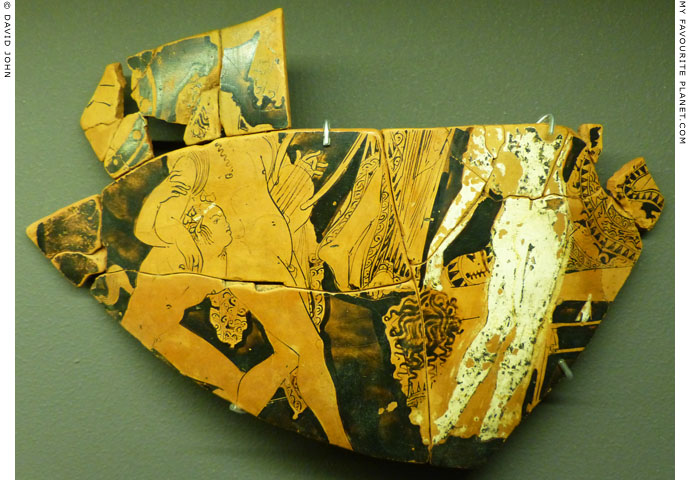
Fragments of an Attic volute krater depicting a drunken Dionysus, supported by a young satyr,
discovering Ariadne. 415-400 BC. From the Sanctuary of the Great Gods, Samothraki, Greece.
Samothraki Archaeological Museum. |
| |

A Roman fresco in Rome labelled "Fresco with Pan and Maenad".
Painted plaster, 193-211 AD.
Antiquarium Communale, Musei Capitolini, Rome.
|
One of several frescos, depicting domestic, rustic and mildly erotic scenes, found in private houses near the Via Nationale in Rome. In this painting a nude male figure wearing a garlanded cap or helmet uncovers a sleeping woman. He does not appear to have horns, and the legs and feet are so crudely drawn that it is difficult to tell whether they are human or goat. The only other indication that he may be the rustic deity is the lagobolon (a crook and hunting stick for throwing at hares) he carries. Otherwise this could well be Dionysus/Bacchus or Pan discovering Ariadne on Naxos.
If this is Pan, then perhaps the artist was wittily putting the male viewer in Dionysus' shoes. The alluring subject of the naked sleeping maenad or sleeping Hermaphroditus, viewed from behind, was common during Roman times, and such statues were placed in the men's section of public baths. |
|
|
| |
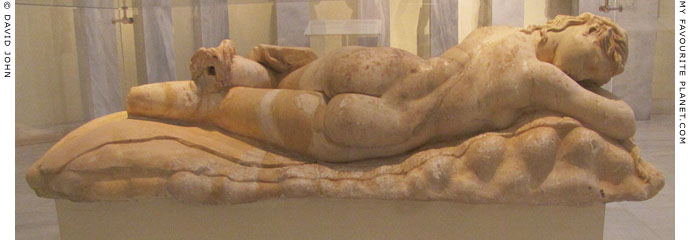
Marble sculpture of the sleeping maenad or sleeping Hermaphroditus.
Pentelic Marble. 1st half of the 2nd century AD. Found in 1880,
south of the Acropolis, Athens. Length 136 cm.
National Archaeological Museum, Athens. Inv. No. 261. |
| |
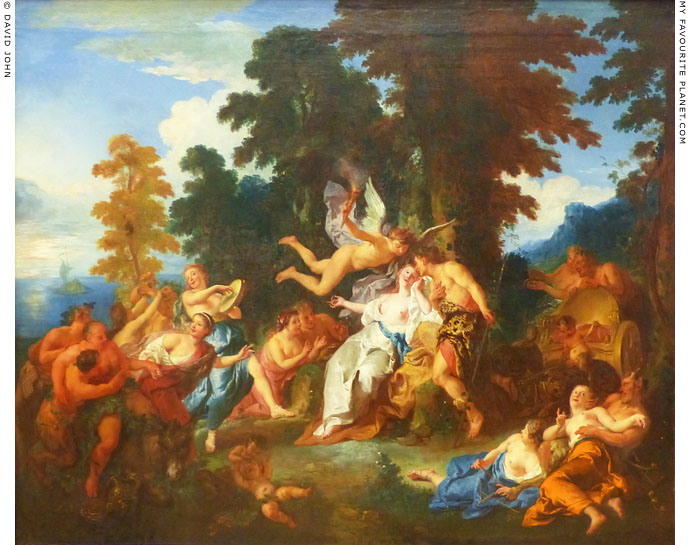
Bacchus and Ariadne by the French painter Jean François de Troy (1679-1752). Oil on canvas, 1717.
The theme of Dionysus and Ariadne on Naxos was revived in European art from the Renaissance.
Bode Museum, Berlin. Kat. KFMV. 241. |
Map, photos and articles: © David John,
except where otherwise specified.
Additional photos: © Konstanze Gundudis
All photos and articles are copyright protected.
Images and materials by other authors
have been attributed where applicable.
Please do not use these photos or articles without permission.
If you are interested in using any of the photos for your
website, project or publication, please get in contact.
Higher resolution versions are available on request. |
|
| |
 |
Visit the My Favourite Planet Group on Facebook.
Join the group, write a message or comment,
post photos and videos, start a discussion... |
|
|
| |
|
|
|